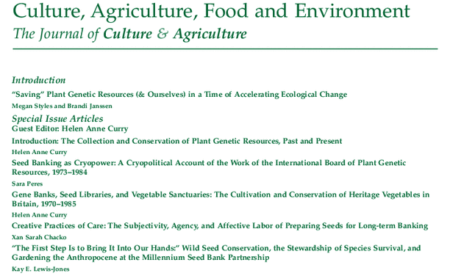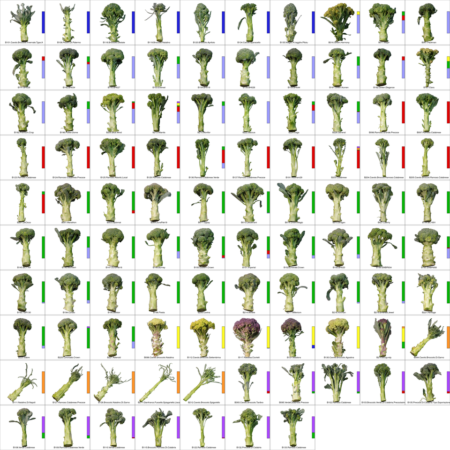- Resequencing of 683 common bean genotypes identifies yield component trait associations across a north–south cline. There’s a fairly straightforward way to select for larger beans as a key component of yield.
- Is the USDA core collection of common bean representative of genetic diversity of the species, as assessed by SNP diversity? Not as much as it could be.
- Diversity, use and production of farmers’ varieties of common bean (Phaseolus vulgaris L., Fabaceae) in southwestern and northeastern Ethiopia. There are more varieties per household in places where the overall number of varieties per community was lower.
- Rapid customization of Solanaceae fruit crops for urban agriculture. Gene editing for shorter tomatoes.
- The home field advantage of modern plant breeding. Public breeding programs should go for specialist varieties that perform reliably in narrow environments.
- Thinking Outside of the Cereal Box: Breeding Underutilized (Pseudo)Cereals for Improved Human Nutrition. The next quinoa awaits its 15 minutes.
- Experimental Cultivation of Eastern North America’s Lost Crops: Insights into Agricultural Practice and Yield Potential. There’s life in the old crops yet. And that’s before gene editing.
- Time for a paradigm shift in the use of plant genetic resources. Genotype everything.
- Using whole-genome SNP data to reconstruct a large multi-generation pedigree in apple germplasm. 3 early modern cultivars had a disproportionate impact on modern apples.
- Machine Learning Reveals Spatiotemporal Genome Evolution in Asian Rice Domestication. The indica and japonica sub-species have exchanged a lot of genetic material at different times, and you get different answers to the question of domestication depending on which bits you look at.
- Genetic Analysis of the Transition from Wild to Domesticated Cotton (G. hirsutum L.). There are fibre quality genes in the subgenome from the parent with unspinnable fibre. Go figure.
- A Comparative Study of Modern and Heirloom Wheat on Indicators of Gastrointestinal Health. Not much difference.
- Target Capture Sequencing Unravels Rubus Evolution. The taxonomy needs work. You don’t say.
- Expansion of the cassava brown streak pandemic in Uganda revealed by annual field survey data for 2004 to 2017. The history of a disease outbreak in excruciating detail.
- Crop prices and the individual decision to migrate. Decrease in the price of coffee in Vietnam (but not rice, which is mainly used for household consumption rather than export) resulted in increased chance of migration, but only for individuals of lower education.
- The contribution of ‘chitoumou’, the edible caterpillar Cirina butyrospermi, to the food security of smallholder farmers in southwestern Burkina Faso. It’s significant, but only during the caterpillar season. I guess they don’t keep. I spot an opportunity. Yeah, you guessed it, gene editing.
Brainfood: Potato genebanks, Aichi 11, Taming foxes, Fruit diversity, Polyploidy review, Evaluating quinoa, Into Africa, IPCC review, Desiccation tolerance, Pig diversity, Oolong diversity, Wild millet, Sustainable diets
- Ex Situ Conservation of Potato [Solanum Section Petota (Solanaceae)] Genetic Resources in Genebanks. The only review of the subject you’ll need. Until the next one.
- Editorial Essay: An update on progress towards Aichi Biodiversity Target 11. Not bad, but the difficult stuff remains difficult. One of several interesting papers.
- The History of Farm Foxes Undermines the Animal Domestication Syndrome. Those Russian foxes were already pretty tame. Here’s a Twitter tread from one of the authors that lays it all out.
- Developing fruit tree portfolios that link agriculture more effectively with nutrition and health: a new approach for providing year-round micronutrients to smallholder farmers. 11 species can address micronutrient gaps.
- Plant Polyploidy: Origin, Evolution, and Its Influence on Crop Domestication. Extreme events and disasters drive polyploidy, which drives diversification at various levels, which facilitates domestication.
- Spectral Reflectance Indices and Physiological Parameters in Quinoa under Contrasting Irrigation Regimes. Phenotyping for drought tolerance from space.
- Asian Crop Dispersal in Africa and Late Holocene Human Adaptation to Tropical Environments. Via NE Africa always something new.
- Invited review: Intergovernmental Panel on Climate Change, agriculture, and food — A case of shifting cultivation and history. The IPCC could have done a better job of synthesizing the data on the impact of climate change on crops and livestock.
- Seed comparative genomics in three coffee species identify desiccation tolerance mechanisms in intermediate seeds. Whole bunch of genes involved.
- Capturing genetic diversity – an assessment of the nation’s gene bank in securing Duroc pigs. Genebank doing a pretty good job in this case.
- Genetic diversity of oolong tea (Camellia sinensis) germplasms based on the nanofluidic array of single-nucleotide polymorphism (SNP) markers. It’s not all the same.
- Tapping Pennisetum violaceum, a wild relative of pearl millet (Pennisetum glaucum), for resistance to blast (caused by Magnaporthe grisea) and rust (caused by Puccinia substriata var. indica). Out of 305 accessions, one was resistant to both diseases. IP21711 if you must know. A few more were resistant to one or the other disease.
- Can Diets Be Healthy, Sustainable, and Equitable? No, and they’ll be difficult to change, but the “burden of change should not be solely placed on the consumer’s ability to make healthy choices.”
Celebrating Nordic collaboration on crop conservation
The current book is a celebration of 40 years of Nordic collaboration on plant genetic resources.
International perspectives are highlighted and the first chapter is written with input from Axel Diederichsen from Plant Gene Resources of Canada and Igor G. Loskutov from the N.I. Vavilov Institute of Plant Genetic Resources (VIR), and the chapter traces lines back to the pioneers and with a specific focus on Vavilov and how he had influenced scientists in the Nordic countries.
Roland von Bothmer and Peter Tigerstedt give an overview of the Nordic plant breeding and genetic resources.
Jens Weibull discusses the role of NGB (and NordGen) in the European genebank collaboration.
A special section is given to a historical recap of how NGB worked with the Gatersleben gene bank in the early 1980s, at a time when computers were large and collaboration with GDR was not straight forward for western countries, and this section is written with inputs from Jan Engels (former Bioversity International) and Helmut Knüpffer (former IPK Gatersleben).
The data management systems at NGB and NordGen are discussed by inputs from Dag Endresen (former IT leader at NGB, now at University of Oslo).
We also have chapters on the collaboration with VIR and the Baltic States, the 100-years experiment on seed longevity in permafrost, and the Svalbard Global Seed Vault.
Regarding the collections, Roland von Bothmer gives the story of the international Hordeum and Triticeae project and Udda Lundqvist of the Swedish Barley Mutant Collection.
The celebration book is finished by chapters on the NordGen’s Plant Genetic Resource Collection of today with perspectives on conservation and use, amongst others the ongoing Public-Private Partnership project, written by the current staff at the genebank and Anders Nilsson at the Swedish University of Agricultural Sciences, Alnarp.
A special thanks to Helmut Knüpffer, Kit Lundborg, Roland von Bothmer and Sara Landqvist for their comments and proof-readings of this book.
Well worth a read.
Culture, Agriculture, Food & Environment, and genebanks
Dr Helen Anne Curry, Peter Lipton Lecturer in History of Modern Science and Technology at the University of Cambridge, guest edited a special issue on “The Collection and Conservation of Plant Genetic Resources” for the journal Culture, Agriculture, Food & Environment in December.
Looks good. A couple of the papers are even open access. I admit I haven’t read them yet, but I will, and report back.
And watch out for Dr Curry’s new project “From Collection to Cultivation: Historical Perspectives on Crop Diversity and Food Security,” which is launching this year with support from a Wellcome Trust Investigator Award.
Visualizing broccoli
Zachary Stansell, who seems like a very interesting guy, had the top post on all of Reddit late last year with — wait for it — a picture of broccoli diversity. And rightly so. It is beautiful.
The coloured bars? They are based on ~10K SNPs, with varieties that share a given colour sharing more of these markers, and being more closely related genetically.

